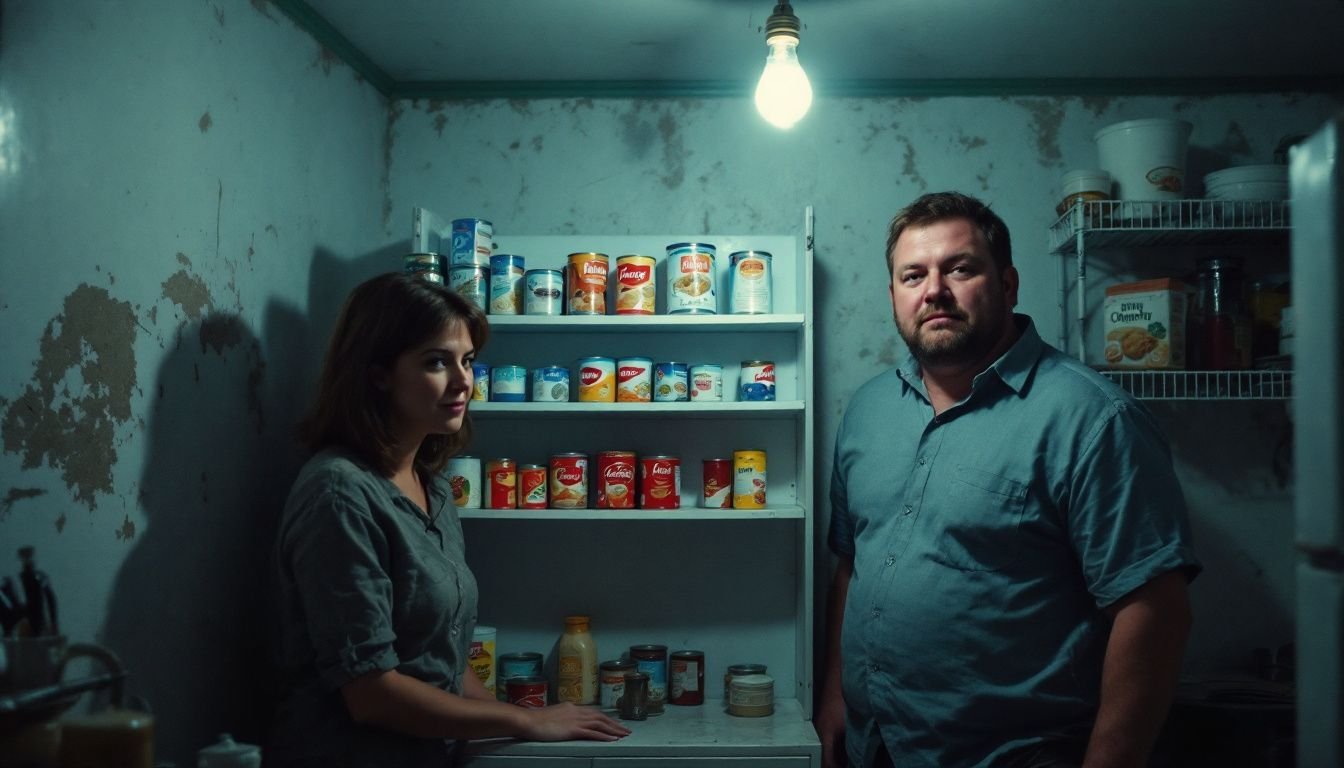Curious about surviving on a tiny food budget? I gave the Live Below the Line challenge a shot. Let me walk you through the journey – by day 3, it gets pretty tough. Stick with me; you might find it eye-opening.
The Live Below the Line Challenge

The Live Below the Line Challenge is tough. You eat on a very small amount of money each day to comprehend the lives of those experiencing extreme poverty. It compels you to prioritize every food choice due to fiscal constraints.
This challenge extends beyond a dietary experiment; it initiates a comprehensive understanding of managing with less and empathizing with the challenges encountered by millions on a daily basis.
I elected for my entire family to participate in this together. We all consented to allocate our scarce finances solely towards fundamental items at the grocery store, such as rice or beans, bypassing any exotic or pre-packaged items.
Every meal transformed into more than mere sustenance; it stood as a demonstration of appreciation and innovation.
Purpose and goals
I took on the Live Below the Line challenge to shine a light on extreme poverty. My goal was clear. I wanted to show how tough it is for families who can’t be sure where their next meal comes from.
The World Food Program USA gets help from this effort. They work hard to give kids in poverty meals they need.
This challenge also made me think about food waste and how every small bit we save can help someone else. By choosing what I eat more carefully, like picking Fair Trade chocolate or UTZ-certified coffee, I make a tiny dent in big issues like child labor in cocoa farms or unfair conditions for workers around the world.
This journey wasn’t just about living with less food; it was my way of standing up against global problems, one meal at a time.
Personal decision-making regarding family participation
Choosing who in my family would join the Live Below the Line challenge was tough. My husband decided not to take part. He thought it wouldn’t fit with his work lifestyle. That made sense to me.
I spend a lot of time at home working and being with our son, often making meals together. We enjoy turning basic ingredients into something special.
For this reason, I chose not to include our son in the challenge. His comfort and nutritional needs were my top concern. It wouldn’t be fair to make him follow such strict limits on food because he’s still growing.
Plus, cooking is our bonding time, where we explore different recipes from unleavened bread to plantain dishes.
Deciding who in your family will face a challenge like this comes down to weighing comfort against learning opportunities.
Day 3 Diary: Like Stealing Candy From A Baby
Today, hunger hit hard. It felt like taking candy from a kid – unfair and tough. I had to choose: feed my craving or make sure my child didn’t go hungry. Every parent knows that’s no choice at all.
So, I passed on the extra slice of homemade bread, saving it for breakfast tomorrow.
My stomach growled as I thought about how easy it used to be to grab a snack. Not today. Instead, I made a simple meal with what little we had—some rice and beans jazzed up with spices found in the back of the cupboard.
It wasn’t much but it filled us up for now.
Hunger can make you grumpy; it did to me today more than ever before. But then I saw my kid laughing and playing, unaware of our food struggle, and it hit me hard—this is why parents do what they do.
I realized something big today. Being hungry changes how you see food and everything else too. What matters most isn.
Managing hunger and cravings
I woke up very hungry. I had about three cups of coffee to help. For the whole day, all I ate was a banana, some coffee, water, and yogurt which cost $0.75 in total. To deal with hunger later, I chewed gum during my trip to the supermarket.
Grocery shopping made me think a lot about food. Seeing all the bread made me miss making it at home with my own sourdough starter. It reminded me of how much effort goes into things we take for granted like cocoa production by workers on farms in Western Africa or chocolate bars at checkout counters that come from fair trade certified sources or even those not so ethical ones involving child labor in cocoa sectors.
Parental sacrifices for child’s well-being
I often cook meals with my son, making sure we use healthy ingredients like oatmeal and gluten-free flours. But on day three of the Live Below the Line challenge, it was harder. After spending two hours at the playground, our hunger levels spiked.
I knew he needed something nutritious, so I made him green juice packed with insoluble fiber. For me, it was just water. Watching him drink while pushing away my own hunger pangs felt like a true test of love and sacrifice.
Choosing his well-being over mine meant adjusting even small details in our daily routine. It’s not just about cutting back on extra treats; it’s ensuring he still gets what his body needs to grow strong and healthy while I take a step back to reflect on our consumption habits.
Every decision from bread making without sugar for healthier options to selecting fairtrade cacao beans when we do indulge is weighed heavily against its impact on both his health and ethical production practices globally.
Impact of extreme hunger on behavior
Extreme hunger changed my behavior in ways I didn’t expect. Eating half of my son’s mac & cheese made me realize how hard it is to control actions when hungry. This meal, worth $1.39, became a major part of our day’s food budget due to limited funds from the Live Below The Line challenge.
Hunger can turn even the most controlled moments into struggles.
The guilt hit hard after realizing I had consumed something meant for my child. It showed me that extreme hunger doesn’t just make you physically weak; it affects your decisions and self-control deeply.
Reflection on the Lesson Learned
Through this challenge, my views on what truly matters shifted greatly. Facing hunger made me put my child’s needs before mine every time.
Altered priorities and selflessness
Hunger changed how I see things. It made me put my child first, always. Even when I wanted to eat more, I would give the better part of our meal to my kid. This challenge showed me that parents will do a lot for their children’s happiness and health.
I learned a big lesson about selflessness during this time. Seeing my child happy and well fed was worth more than any food I could have eaten myself. This feeling surprised me. It taught me much about what matters most in life – caring for others before yourself.
Parental behavior in the face of hunger
I faced intense hunger. This led me to take food from my child. I thought about how parents act when they’re very hungry. They might do things they wouldn’t usually do, like taking a small bite of their child’s dinner even if it means less for the kid.
This made me see how hunger can change what parents think is okay. It’s hard but shows we will go far to stop our own hunger, even if it affects those we love most.
Conclusion
Taking part in the Live Below the Line Challenge taught me a lot. I learned how hard it is to manage hunger when you have very little food. It showed me what parents will give up for their kids’ happiness and well-being.
Most of all, it opened my eyes to how extreme hunger can change your actions, like when I ate my child’s mac & cheese because I was so hungry. This journey made me understand the value of caring for others even when times are tough.
FAQs
1. What is the Harkin-Engel Protocol, and how does it relate to child labor in cocoa production?
The Harkin-Engel Protocol is an international agreement aimed at ending the worst forms of child labor on cocoa farms. It involves major players in the chocolate industry like Barry Callebaut, Hershey’s, Mars, Nestlé USA, and Mondelēz.
2. How are organizations like UTZ Certified and Rainforest Alliance involved with child labor issues in cocoa farming?
UTZ Certification and Rainforest Alliance are organizations that provide certifications for ethical practices including fair treatment of laborers on cocoa farms. They work closely with companies such as supermarkets to ensure their suppliers adhere to these standards.
3. Can you share some insights about children working on Western African plantations?
Unfortunately, many children are trafficked from other African countries to work as slaves or debt-bonded laborers on Western African plantations where commodity crops like cocoa beans are harvested.
4. What’s the role of International Labour Organization (ILO) and World Cocoa Foundation (WCF) in this issue?
Both ILO and WCF play a significant role in raising public discourse around these issues by advocating for formerly enslaved children’s rights while pushing for reforms within the chocolate industry.
5. How do large corporations respond to allegations regarding child workers harvesting their raw materials?
Companies such as Cargill have been known to participate actively with bodies such as UTZ Certified or Rainforest Alliance for obtaining certification which ensures ethical sourcing processes free from exploitation involving child workers.
6.What steps can consumers take if they want to avoid supporting this form of human trafficking indirectly?
Consumers can choose products certified by reputable bodies ensuring fair trade practices; they can also raise awareness about ‘the dark side of chocolate’ through various platforms thereby influencing change.
- Discover 10 Employee Health Benefits Cheaper Than Insurance In 2024 - November 9, 2024
- 4 Common Money Mistakes Parents Make And How To Avoid Them - November 9, 2024
- Mastering Your Retirement Strategy: Essential Steps For Financial Security - November 9, 2024
















